
Nizhny Novgorod is 800 years young!
/ Главная / Russkiy Mir Foundation / Publications / Nizhny Novgorod is 800 years young!Nizhny Novgorod is 800 years young!
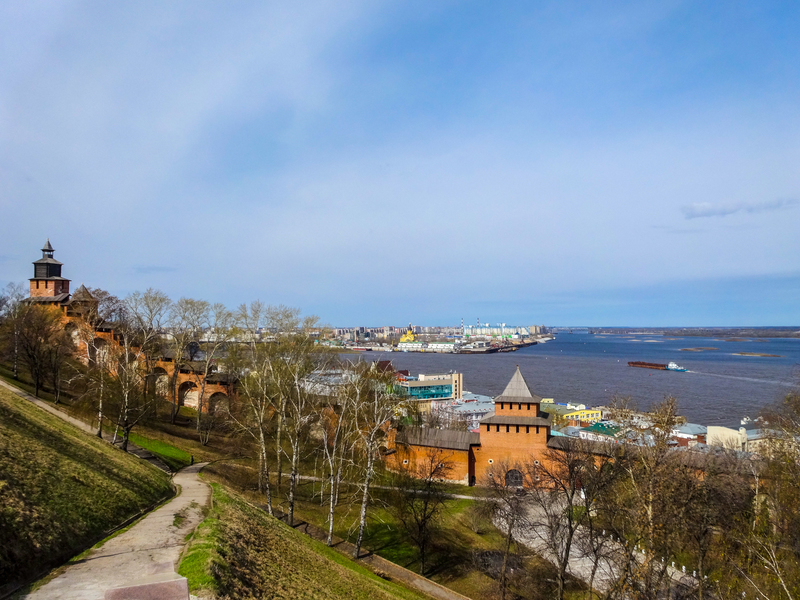
Nizhny Novgorod Kremlin. Photo credit: Nikolay / pxhere.com
Зenultimate summer weekend in Russia is marked by the 800th anniversary of Nizhny Novgorod. The city on the Volga River has celebrated its milestone birthday on a large scale - throughout the whole of Russia - from August 19 to 21. There were concerts, festivals, regattas, and fireworks - the events that were missed so badly during eighteen months of coronavirus.
Anniversary projects about the unique history of Nizhny Novgorod featured by museums, libraries, theaters, and online platforms may not be as vivid and pompous as the fireworks and choir of 800 singers on the Chkalov Stairs, but they have certainly been noticed.
Visitors who come to Nizhny Novgorod during the anniversary year or search for information about the anniversary online can get acquainted with the city, which has lived and developed with the mission to save the Fatherland throughout its whole history, be it the Old Russian era, the Time of the Troubles, or the Great Patriotic War.
The city was built as a fortress against eastern tribes’ raids on Russia, and here Minin and Pozharsky organized the people’s volunteer army that chased the Polish invaders out of Moscow. And centuries later the city put up 56 military units and 35,000 citizens-in-arms against Hitler; the factories of Gorky, one of the industrial capitals of the country, produced almost 40,000 tanks and over 16,000 aircraft during the war.

Nizhny Novgorod, residential area. Photo credit: Photobank Moscow-Live / flickr.com
View from the Kremlin
Nizhny Novgorod cannot be called a province or a hinterland. And it has long outgrown the title of a regional center. In many ways, Nizhny Novgorod residents live the life of the capital. First of all, the city has its own Kremlin that is unique from both architectural and historical viewpoints. It is called the most impregnable Kremlin of Russia because it confronted sieges five times and was not overtaken. During the Great Patriotic War, the Kremlin became a fortress once again. Anti-aircraft guns were installed on its towers to fight back enemy air raids.
Speaking of towers, the stone fortress in Nizhny Novgorod has existed for more than five hundred years. It was laid in the early 16th century, but construction was slow at first. The former wooden Kremlin managed to deter attacks by Tatars and other nations. After the oak fortress burned down, construction progressed much faster - the architect Pietro Francesco was sent from Moscow. The Nizhny Novgorod fortress was extremely important.
Nizhny Novgorod remained faithful to Moscow during the most challenging periods of Russian history. During the Time of Troubles, Polish invaders seized most of the country, but Nizhny Novgorod’s residents managed to keep the enemy out of the city. Moreover, it was here that the people's volunteer army was organized and it went to liberate Moscow.
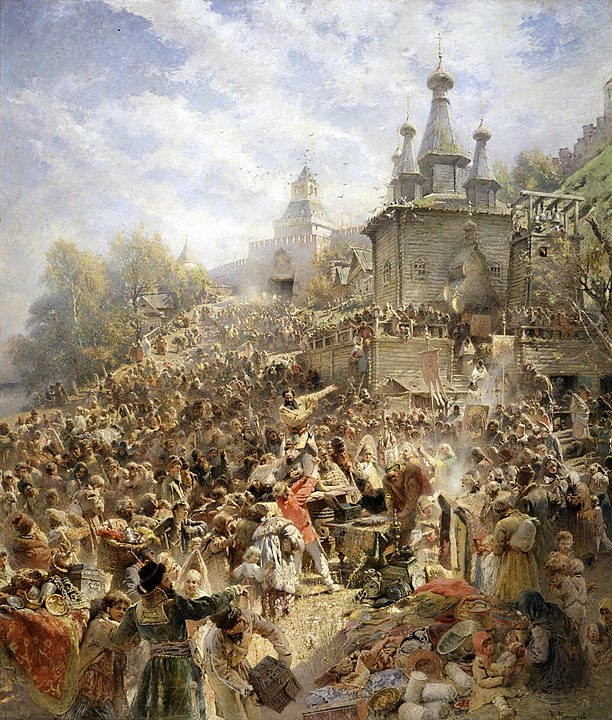
Painting by Konstantin Makovsky. Minin's Appeal to the People of Nizhny Novgorod, 1896
The Russian merchant, new zemstvo (organ of rural self-government in the Russian Empire) headman Kuzma Minin urged his fellow countrymen to do this. Prince Dmitry Pozharsky, who lived not far from the city, was chosen as head of the volunteer army at one of the national gatherings. What happened next, most Russians know from school textbooks and movies.
In order to deepen and clarify this knowledge, last year, the chairman of the State Duma Committee on Education and Science, Doctor of Historical Sciences Vyacheslav Nikonov announced the establishment of the History of Nizhny Novgorod online project dedicated to the 800th anniversary of the city. Vyacheslav Nikonov was elected to parliament from Nizhny Novgorod and heads the Nizhny Novgorod branch of the Russian Historical Society
“I should note that Nizhny Novgorod residents are too modest in assessing the role of their land in Russian and world history. And Russians are little aware of what they owe to Nizhny Novgorod land. I'll try to fix that," said Nikonov launching the project.
Currently, the portal features more than eighty articles about the city’s history and its prominent residents. One of the largest sections is "How Nizhny Novgorod Saved Russia". Here, the Nizhny Novgorod feat under the leadership of Minin and Pozharsky is described in detail with references to historians from different centuries, archival documents, and testimonies of participants and eyewitnesses. Lively figurative language enables visitors to read the chapters about the Time of Troubles as a fascinating book.
It is noted that the role of Nizhny Novgorod/Gorky in the Great Patriotic War will be a separate topic of publications on the portal. "Nizhny Novgorod residents defended their homeland in the Great Patriotic War. It was here that the country's defense shield was forged. It enabled the country to crush Hitler's Germany - half of the Soviet artillery, a third of tanks and aircraft were produced here," says Vyacheslav Nikonov.
Gorky had to undertake the role of nearly the major industrial city of the country after the other big industrial centers had ended up in the war zone. Saving the Fatherland is its second nature. The Germans were rushing into the city, and while they were not able to reach its walls, they showered Nizhny Novgorod with air bombs.
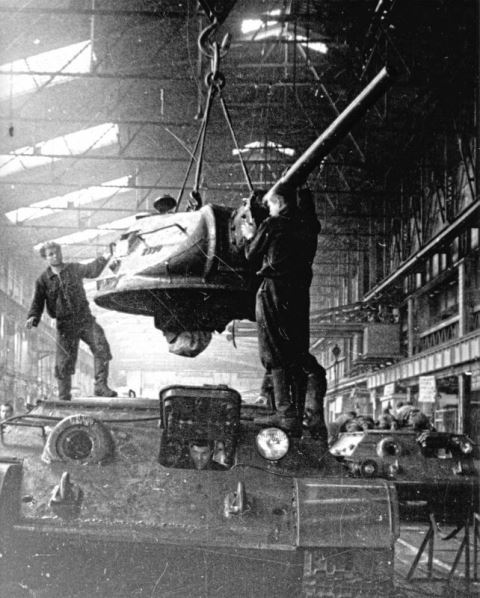
Assembly of T-34 tanks during the Great Patriotic War, 1941-42. Plant No. 112 in Gorky (Nizhny Novgorod). Photo credit: waralbum.ru
In 1943, during three large-scale air raids, more than 3.5 thousand bombs were dropped on the Molotov Automotive Plant, which was the main manufacturer of military equipment for the front. Hardly anything remained of the plant, but in 1944 it was rebuilt by efforts of Nizhny Novgorod residents. The shield came back to the battle being even stronger than before.
Ay, ships of every flag shall come
Kremlin is not the only landmark in Nizhny Novgorod that holds the title of the mostest. The city has the longest pedestrian stairs in Russia (560 steps). It was named as a tribute to the pilot Chkalov, a native of the Nizhny Novgorod region, who made the first non-stop flight over the North Pole from Moscow to America. And also Nizhny Novgorod has the longest cableway in Russia and Europe – it is more than three kilometers long.

Chkalov Stairs. Photo credit: Photobank Moscow-Live / flickr.com
Nizhny Novgorod is a city of high culture; it is one of the theater capitals of Russia. There are fifteen theaters, hundreds of historical and cultural monuments, and there is also Nizhny Novgorod's Arbat - Bolshaya Pokrovskaya Street. It is a pedestrianized street where tourists from all over the world enjoy walking all year round.

Pedestrianized street in the center of Nizhny Novgorod. Photo credit: tortic84 / pixabay.com
Not only Russian writers but also foreign classics left notes about the city. The author of The Three Musketeers, Alexandre Dumas père, admitted that he “cried out in surprise at the vision that opened up in front of us. We were at the confluence of the Volga and Oka rivers; there was a huge territory of the fair below.”
Indeed, Nizhny Novgorod is one of the largest cities in Russia located on an important river route. In addition to being an important industrial center, it has always been famous for its merchant, commercial spirit. The American novelist Theodore Dreiser visited Nizhny Novgorod in 1927. He endowed the city with lots of compliments for its...American spirit. "With all these purely Russian appealing features, it seems to me to have quite a modern, noisy, lively atmosphere of an American city," Dreiser wrote.
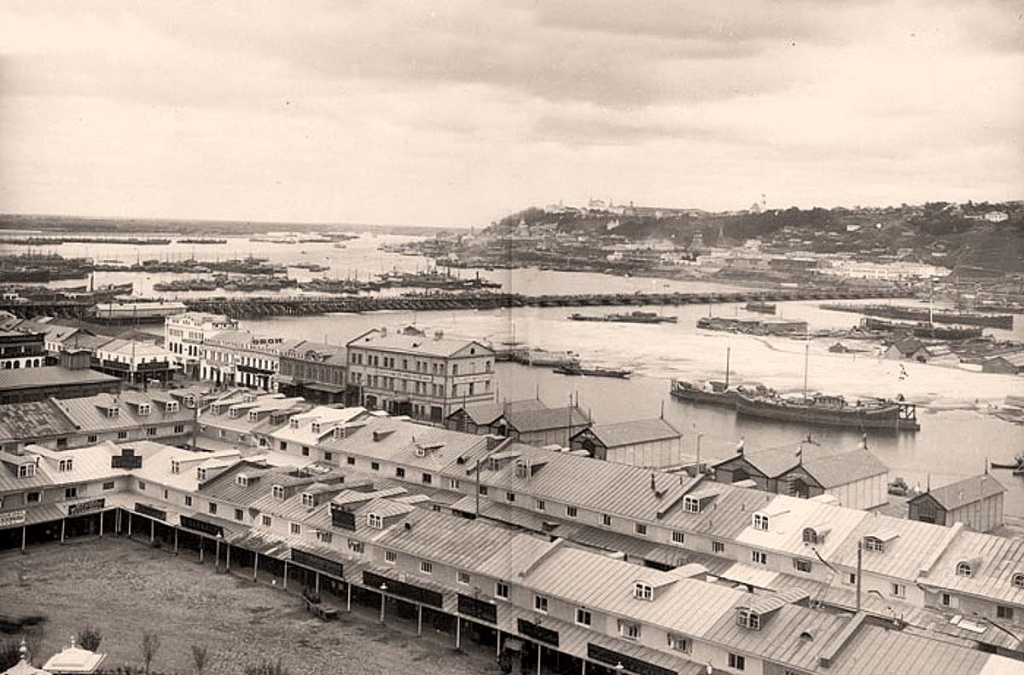
Merchants’ rows of the fair in Nizhny Novgorod, Kunavinskaya Sloboda, 19th century. Photo credit: nailtimler.com
Being located at the crossing of trade routes, Nizhny Novgorod was always full of foreigners. "Pearls were brought here by an Indian; a European brought counterfeit wines, a breeder from the steppes brought a herd of bad horses," Pushkin wrote about Nizhny Novgorod in his Yevgeniy Onegin.
Vyacheslav Nikonov reports about it in one of his articles. "The city was the gateway for many domestic and foreign commodity flows, such as salt from Balakhna, from the Kama and Astrakhan, Volga fish, leather, textiles, bread from the Oka region, Russian and European goods from Moscow and Yaroslavl, Bukhara, Persian, and Indian goods from Astrakhan, furs from Siberia," he points out.
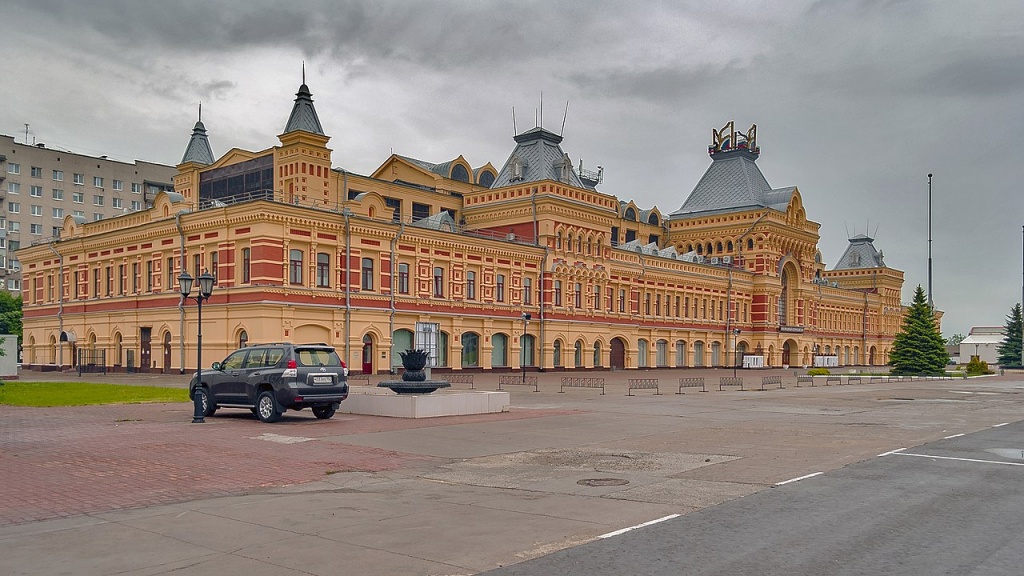
The main fair building, present days. Photo credit: Alexey Trefilov / ru.wikipedia.org
In 2020, the city celebrated the 30th anniversary of the return of its historical name (in the Soviet years it was renamed to Gorky to commemorate its famous native). This year, in addition to its 800th anniversary, Nizhny Novgorod has another reason to celebrate - the restrictions on visits by foreign tourists were lifted thirty years ago... So Pushkin's "Ay, ships of every flag shall come" is also about Nizhny Novgorod as it ceased to be a closed city. The writer Maxim Gorky is one of the magnets for foreigners since he spent his childhood in Nizhny.

Assumption Church on Ilinskaya Hill. Photo credit: ssa66 / pixabay.com
“Recently, I conducted a tour for a married couple from France,” said the Nizhny Novgorod guide Irina Potrikeyeva. “The man's ancestors in the third generation were emigrants from Russia, and he wanted to get to know the country from various angles. I started the usual tour that we have for foreigners telling about the history of the city and so on. But we started talking about Gorky – that was it, the route had to be changed, we literally ran through the Gorky’s places. The French were very interested in everything related to the writer. Abroad, Gorky is known and honored.”
New publications

 Mikhail Kalatozov, a director who transformed the world of cinematography in many ways, was born 120 years ago. He was a Soviet film official and a propagandist. Above all, he was capable of producing movies that struck viewers with their power and poetic language.
Mikhail Kalatozov, a director who transformed the world of cinematography in many ways, was born 120 years ago. He was a Soviet film official and a propagandist. Above all, he was capable of producing movies that struck viewers with their power and poetic language.  Ukrainian authorities have launched a persecution campaign against the canonical Ukrainian Orthodox Church (UOC), the biggest one in the country's modern history. Over the past year, state sanctions were imposed on clergy representatives, searches were conducted in churches, clergymen were arrested, criminal cases were initiated, the activity of the UOC was banned in various regions of the country, and monasteries and churches were seized.
Ukrainian authorities have launched a persecution campaign against the canonical Ukrainian Orthodox Church (UOC), the biggest one in the country's modern history. Over the past year, state sanctions were imposed on clergy representatives, searches were conducted in churches, clergymen were arrested, criminal cases were initiated, the activity of the UOC was banned in various regions of the country, and monasteries and churches were seized.  When Nektary Kotlyaroff, a fourth-generation Russian Australian and founder of the Russian Orthodox Choir in Sydney, first visited Russia, the first person he spoke to was a cab driver at the airport. Having heard that Nektariy's ancestors left Russia more than 100 years ago, the driver was astonished, "How come you haven't forgotten the Russian language?" Nektary Kotlyaroff repeated his answer in an interview with the Russkiy Mir. His affinity to the Orthodox Church (many of his ancestors and relatives were priests) and the traditions of a large Russian family brought from Russia helped him to preserve the Russian language.
When Nektary Kotlyaroff, a fourth-generation Russian Australian and founder of the Russian Orthodox Choir in Sydney, first visited Russia, the first person he spoke to was a cab driver at the airport. Having heard that Nektariy's ancestors left Russia more than 100 years ago, the driver was astonished, "How come you haven't forgotten the Russian language?" Nektary Kotlyaroff repeated his answer in an interview with the Russkiy Mir. His affinity to the Orthodox Church (many of his ancestors and relatives were priests) and the traditions of a large Russian family brought from Russia helped him to preserve the Russian language.

 The leaders of the Friends of the Great Russia cultural association (Amici Della Grande Russia) in Italy believe that the Western policy of abolishing Russian culture in Europe has finally failed. Furthermore, it was doomed to failure from the beginning.
The leaders of the Friends of the Great Russia cultural association (Amici Della Grande Russia) in Italy believe that the Western policy of abolishing Russian culture in Europe has finally failed. Furthermore, it was doomed to failure from the beginning.  Name of Vladimir Nemirovich-Danchenko is inscribed in the history of Russian theater along with Konstantin Stanislavski, the other founding father of the Moscow Art Theater. Nevertheless, Mr. Nemirovich-Danchenko was a renowned writer, playwright, and theater teacher even before their famous meeting in the Slavic Bazaar restaurant. Furthermore, it was Mr. Nemirovich-Danchenko who came up with the idea of establishing a new "people's" theater believing that the theater could become a "department of public education."
Name of Vladimir Nemirovich-Danchenko is inscribed in the history of Russian theater along with Konstantin Stanislavski, the other founding father of the Moscow Art Theater. Nevertheless, Mr. Nemirovich-Danchenko was a renowned writer, playwright, and theater teacher even before their famous meeting in the Slavic Bazaar restaurant. Furthermore, it was Mr. Nemirovich-Danchenko who came up with the idea of establishing a new "people's" theater believing that the theater could become a "department of public education."  "Russia is a thing of which the intellect cannot conceive..." by Fyodor Tyutchev are famous among Russians at least. December marks the 220th anniversary of the poet's birth. Yet, he never considered poetry to be his life's mission and was preoccupied with matters of a global scale. Mr.Tyutchev fought his war focusing on relations between Russia and the West, the origins of mutual misunderstanding, and the origins of Russophobia. When you read his works today, it feels as though he saw things coming in a crystal ball...
"Russia is a thing of which the intellect cannot conceive..." by Fyodor Tyutchev are famous among Russians at least. December marks the 220th anniversary of the poet's birth. Yet, he never considered poetry to be his life's mission and was preoccupied with matters of a global scale. Mr.Tyutchev fought his war focusing on relations between Russia and the West, the origins of mutual misunderstanding, and the origins of Russophobia. When you read his works today, it feels as though he saw things coming in a crystal ball...